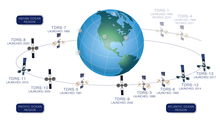TDRS-3
[5] TDRS-C was deployed from Discovery around six hours after launch, and was raised to geostationary orbit by means of an Inertial Upper Stage.
The first stage burn occurred shortly after deployment from Discovery, and placed the satellite into a geosynchronous transfer orbit.
At 04:30 UTC on 30 September 1988, it reached apogee, and the second stage fired, placing TDRS-C into geosynchronous orbit.
[7][8] In June 1995, it was moved to 85.0° East, from where it was used primarily for communications with spacecraft such as the Compton Gamma Ray Observatory and the Hubble Space Telescope.
[7][9] In October 2009, as NASA began decommissioning TDRS-1, TDRS-3 was moved to 49.0° West,[10] where it remains in storage as of 2020.


